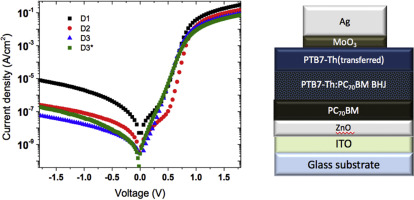Organic Electronics ( IF 2.7 ) Pub Date : 2018-06-28 , DOI: 10.1016/j.orgel.2018.06.032 Hyunsoo Kim , Byeongseop Song , Kyusang Lee , Jinsang Kim , Jerzy Kanicki

|
We demonstrated a high performance low-bandgap organic polymer photodiode (OPD), with broadband spectrum, with transferred charge blocking layers. Besides the popular P3HT:PCBM bulk heterojucnction (BHJ) system, we investigated the OPD performance of PTB7-Th:PC70BM BHJ active layer with transfer printed charge blocking layer. To achieve higher performance OPD with lower dark current and higher responsivity, various device structures employing hole blocking layer (HBL) or and electron blocking layer (EBL) were investigated. A very low dark current of ∼5 nA/cm2 at reverse bias 0.5 V was achieved with BHJ active layer sandwiched between both HBL and EBL resulting in high specific detectivity of 1.48 × 1013 Jones at 700 nm. In addition, critical noise current measurement of the OPD was done to evaluate more accurately Noise Equivalent Power (NEP) value. It turned out that the shot noise is dominant over the thermal noise in the OPD verified by the in-depth noise analysis. More deliberate design of the device structure can deliver higher performance OPD cell with developed transfer printing method for use in organic photodetectors image sensors.
中文翻译:

高性能PBT7-Th:PC 70 BM聚合物光电二极管,带有转移的电荷阻挡层
我们展示了一种具有宽带光谱的高性能低带隙有机聚合物光电二极管(OPD),具有转移的电荷阻挡层。除了流行的P3HT:PCBM本体异质结(BHJ)系统之外,我们还研究了带有转移印刷电荷阻挡层的PTB7-Th:PC70BM BHJ有源层的OPD性能。为了以更低的暗电流和更高的响应度实现更高性能的OPD,研究了采用空穴阻挡层(HBL)或电子阻挡层(EBL)的各种器件结构。通过在HBL和EBL之间夹有BHJ有源层,在反向偏置0.5 V时实现了非常低的暗电流〜5 nA / cm 2,从而导致1.48×10 13的高比探测率琼斯在700 nm。此外,还对OPD进行了临界噪声电流测量,以更准确地评估噪声等效功率(NEP)值。事实证明,在经过深入噪声分析验证的OPD中,散粒噪声比热噪声占主导地位。器件结构的更精心设计可以通过用于有机光电探测器图像传感器的发达转移印刷方法,提供性能更高的OPD单元。







































 京公网安备 11010802027423号
京公网安备 11010802027423号